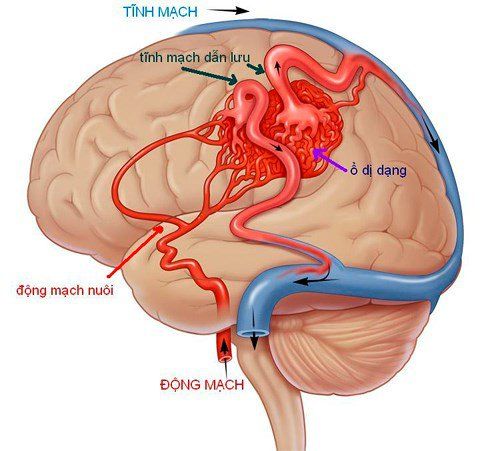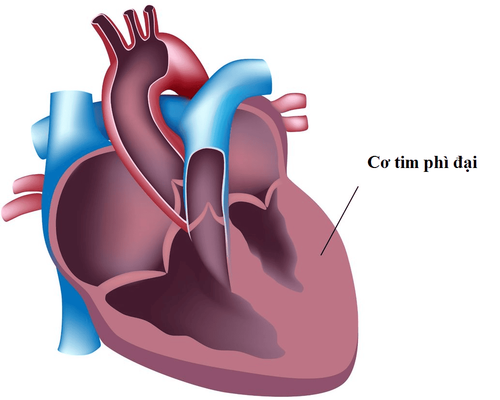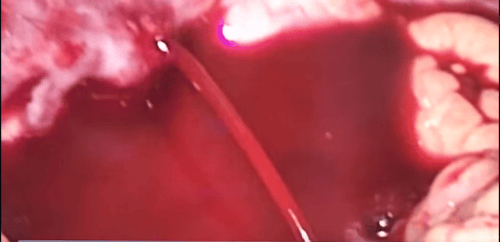This is an automatically translated article.
This article is expertly consulted by Master, Doctor Bui Ngoc Phuong Hoa - General Internal Medicine - Department of Medical Examination & Internal Medicine - Vinmec Danang International General Hospital. The doctor has more than 24 years of experience in the field of Psychiatry.Cerebrovascular malformations usually develop between the 4th and 8th weeks of pregnancy. The cause of the disease may be genetic and angiogenesis-stimulating activity. Cerebral vascular malformations will also reduce oxygen to brain tissue.
1. Is cerebrovascular malformation dangerous?
Cerebrovascular malformation is an abnormal connection between arteries and veins in the body. The arteries are responsible for transporting oxygen-rich blood from the heart to the brain. Veins carry hypoxic blood back to the lungs and heart. When the cerebral arterioles are malformed, this important process is disrupted.Cerebrovascular malformations account for about 2% of all hemorrhagic strokes each year and are often the cause of bleeding in children and young adults with intracerebral hemorrhage.
Cerebrovascular malformation will also reduce oxygen to brain tissue. With cerebrovascular malformations, blood bypasses the capillary network and flows directly from the artery to the vein. Blood flows quickly through the blood vessels because it is not slowed down by the capillaries, resulting in the surrounding brain tissue being unable to easily absorb oxygen from the blood due to the rapid flow. Without enough oxygen, brain tissues weaken or may die completely.

2. Symptoms of cerebrovascular malformation
Cerebral vascular malformation is very dangerous. When there is a cerebrovascular malformation, the patient will experience bleeding in the brain and cause the malformed arteries and veins to become thin or weak and can lead to the rupture of the malformed cerebral blood vessel and bleeding into the brain.Stroke-like symptoms, difficulty speaking, weakness, numbness, decreased vision. This malformation also causes the blood vessel to thin or weaken, creating an aneurysm, which can enlarge and easily rupture.
Due to the abnormal connection between the artery and the vein, the blood flows through the malformed blood vessel with high pressure and fast. Cerebral vascular malformation causes many problems, the most common of which is the rupture of a blood vessel leading to a stroke due to hemorrhagic stroke or increased intracranial pressure leading to seizures, convulsions, and a very high risk of sudden death. .

3. Cerebral vascular malformation inherited?
This is a congenital disease that develops from the fourth to the eighth week of pregnancy that causes arteries to connect directly to veins without an intermediate capillary network, so most cerebrovascular malformations can persist. stay in the brain for a long time without any symptoms.However, it is still controversial because cerebrovascular malformations can be related to many factors including heredity and angiogenic activity (this is a physiological process where, New blood vessels form from pre-existing blood vessels) may play an important role in the occurrence of vascular malformations.
4. Signs of cerebrovascular malformation
Most patients with cerebrovascular malformations are asymptomatic, often discovered incidentally while being treated for an unrelated condition.Cerebral vascular malformation when rupture is very fatal and is common after cerebral aneurysms. The prevalence of the disease in the community is about 0.15% - 1.0%, it can be seen in the age group of 15 - 50 years old. Men are more affected than women.
5. Methods of diagnosing cerebrovascular malformations
Cerebral angiogram (DSA): Doctors can see the exact location and size of this malformation. This is considered the most accurate test. Computed tomography (CT scan): Uses X-rays to take pictures of different parts of the body. A CT scan can show a cerebral vascular malformation, especially after X-ray contrast is introduced. Magnetic resonance imaging (MRI): This is a method of creating highly detailed images of the body without taking X-rays. Angiography uses specially designed “pulse sequences” to show the arteries and veins of the brain as well as cerebrovascular malformations. Vinmec International General Hospital performs routine cerebral vascular magnetic resonance imaging in screening for cerebrovascular abnormalities. Many cases of cerebrovascular malformations have been detected in patients with only headache and early intervention has resolved the risk of brain aneurysm rupture causing very severe stroke or death.With the generation of 3.0 Tesla magnetic resonance machine, the silent technology of GE, USA, has created absolute comfort for the patient when examining because there is absolutely no annoying noise when taking pictures. Magnetic Resonance.
Please dial HOTLINE for more information or register for an appointment HERE. Download MyVinmec app to make appointments faster and to manage your bookings easily.














